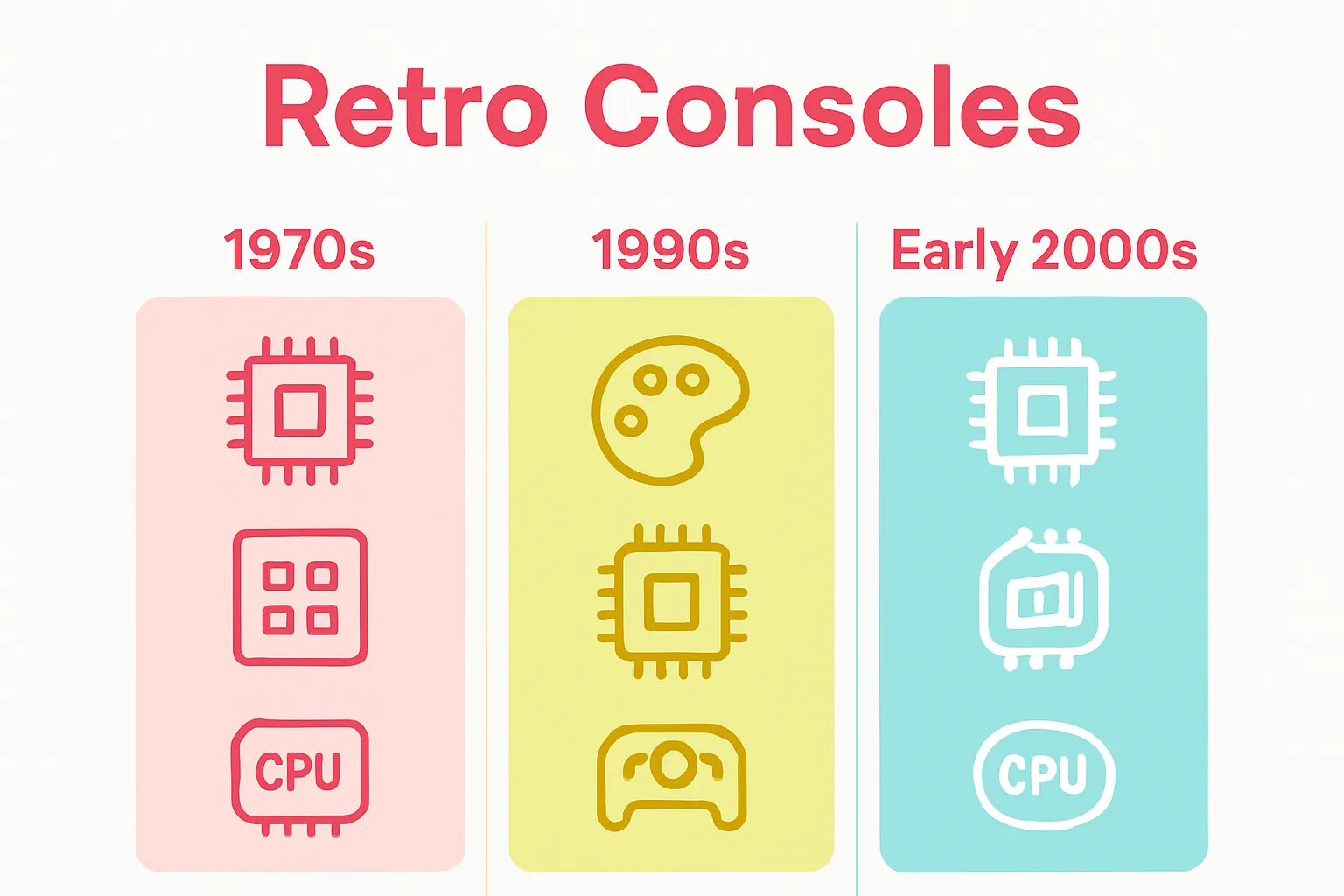
Understanding the Retro Gaming Console Guide: Nostalgic Fun
Share
Retro gaming consoles spark memories of a time when chunky controllers and pixelated screens ruled the lounge room. Most people think of these gadgets as simple throwbacks, just for nostalgia or old-school fun. But what stands out is that many retro consoles use advanced emulation software to perfectly recreate decades-old games right down to the tiniest detail, turning them into cultural time capsules and not just toys from the past.
Table of Contents
- What Is A Retro Gaming Console?
- The Cultural Impact Of Retro Gaming
- How Retro Consoles Work: Technology And Design
- Key Features And Characteristics Of Retro Consoles
- Collecting Retro Consoles: Why It Matters
Quick Summary
| Takeaway | Explanation |
|---|---|
| Retro consoles emulate classic gaming systems | These devices recreate the experience of vintage gaming platforms from past decades, providing authentic gameplay. |
| Nostalgia connects generations | Retro gaming bridges the gap between older and younger players, fostering shared experiences and memories. |
| Preservation of digital heritage is essential | Collecting retro consoles helps maintain a record of technological and cultural milestones in gaming history. |
| Emulation technology is key | Modern retro consoles effectively use emulation to accurately replicate the hardware and software of original systems. |
| Unique design shapes gaming experiences | Retro consoles feature iconic aesthetics and technical specifications that reflect their historical context, influencing game design creativity. |
What is a Retro Gaming Console?
A retro gaming console represents a nostalgic bridge between classic video game technology and modern entertainment experiences. These specialized devices allow gamers to relive iconic digital memories by recreating vintage gaming platforms from previous decades. Explore our guide on classic gaming consoles to understand their unique cultural significance.
Understanding the Core Concept
Retro gaming consoles are dedicated electronic devices designed to emulate or reproduce original gaming systems from the 1970s through the early 2000s. Unlike contemporary gaming platforms, these consoles focus on preserving authentic gameplay experiences by maintaining original hardware specifications, graphic aesthetics, and control mechanisms. They typically feature pre-loaded game libraries that showcase iconic titles from specific gaming eras, allowing users to experience games exactly as they were initially designed.
Technical Characteristics and Design
Most retro gaming consoles share several distinctive technical characteristics. They often incorporate compact design elements reminiscent of original console generations, integrating miniaturized hardware that can connect directly to modern television sets. According to research from Gaming Historian, these devices generally include:
- High-definition video output compatibility
- Authentic controller replicas matching original designs
- Emulation software mimicking original system architectures
- Preset game collections representing significant gaming periods
The primary appeal of retro gaming consoles lies in their ability to transport players back in time, allowing them to experience gaming history firsthand. By preserving classic interactive experiences, these devices serve not just as entertainment tools but as important cultural artifacts that celebrate video game heritage.
To help you quickly understand what sets retro gaming consoles apart, here is a summary table featuring their key technical and design characteristics, as discussed in the article.
| Feature | Description |
|---|---|
| Compact Design | Small footprint hardware echoing original consoles, easily connects to modern TVs |
| High-Definition Video Output | Supports modern video standards while preserving classic visuals |
| Authentic Controller Replicas | Controllers closely match the original feel, often with ergonomic tweaks |
| Emulation Software | Software mimics original hardware and game logic precisely |
| Preset Game Libraries | Loaded with iconic titles from specific decades or platforms |
| Robust Physical Build | Built for durability, reflecting sturdy designs of early gaming eras |
| Iconic Visual Aesthetics | Retains the distinctive style and branding of classic systems |
The Cultural Impact of Retro Gaming
Retro gaming transcends mere entertainment, emerging as a powerful cultural phenomenon that bridges generational experiences and preserves digital heritage. Dive deeper into retro gaming culture to appreciate its profound societal significance.
Generational Connections and Nostalgia
Retro gaming serves as a unique intergenerational bridge, allowing older players to reconnect with cherished childhood memories while introducing younger generations to classic gaming experiences. These vintage games represent more than simple digital interactions - they are living historical artifacts that capture specific technological and cultural moments. According to Gaming Anthropology Research, retro games provide tangible links to past technological innovations and social dynamics.
Preserving Digital Cultural Heritage
The cultural impact of retro gaming extends beyond personal nostalgia, functioning as a critical method of digital preservation. These games document significant technological milestones, artistic expressions, and storytelling techniques that might otherwise be forgotten. Key aspects of this preservation include:
- Documenting technological evolution in interactive media
- Maintaining complex narrative structures from early game design
- Archiving visual and audio design approaches from different eras
- Celebrating creative achievements in early digital entertainment
Moreover, retro gaming has sparked academic and archival interest, with museums and academic institutions recognizing these digital experiences as important cultural expressions. By maintaining and celebrating these gaming experiences, enthusiasts ensure that future generations can understand and appreciate the rich history of interactive digital entertainment.
This table highlights the various ways in which retro gaming contributes to both generational connection and cultural preservation, as reflected throughout the article.
| Cultural Element | Retro Gaming Impact |
|---|---|
| Generational Bridge | Fosters shared experiences between older and younger players |
| Technological Documentation | Chronicles key advances in interactive digital media |
| Narrative & Design Archive | Maintains early storytelling and visual/audio approaches |
| Creative Achievement Showcase | Celebrates ingenuity in overcoming technical constraints |
| Academic & Museum Interest | Recognised by institutions as vital to digital culture preservation |
| Social History Reflection | Captures societal trends and innovations of past gaming eras |
How Retro Consoles Work: Technology and Design
Retro gaming consoles represent complex technological recreations that blend nostalgic hardware design with modern digital engineering. Explore the retro gaming resurgence phenomenon to understand their technological evolution.
Emulation Technologies
Emulation serves as the fundamental technological backbone of modern retro gaming consoles. According to comprehensive research on digital preservation, these devices use sophisticated software and hardware techniques to accurately reproduce original gaming system architectures. The emulation process involves creating precise digital replicas of vintage computer systems, including their processor logic, graphic rendering capabilities, and sound generation mechanisms.
Hardware and Design Considerations
Modern retro consoles incorporate sophisticated design strategies to maintain authenticity while leveraging contemporary technological capabilities. These devices typically feature:

- Miniaturized circuit boards mimicking original console architectures
- High-definition video output compatibility
- Authentic controller designs with modern ergonomic improvements
- Advanced chipsets capable of precise system emulation
The engineering behind these consoles requires intricate reverse engineering of classic gaming platforms, ensuring that every pixel, sound, and gameplay mechanic remains true to the original experience. Developers meticulously reconstruct complex computational environments that can run decades-old game code with remarkable accuracy, creating a bridge between historical gaming technology and modern interactive entertainment.
Key Features and Characteristics of Retro Consoles
Retro gaming consoles represent intricate technological artifacts that encapsulate specific historical gaming experiences. Learn more about iconic retro gaming stations to appreciate their unique design philosophies.
Physical Design and Aesthetics
Classic retro consoles are distinguished by their distinctive physical characteristics, often reflecting the technological limitations and design sensibilities of their original eras. According to historical gaming technology research, these devices typically featured robust physical interfaces that contrasted sharply with contemporary sleek digital designs. The physical construction of these consoles prioritized durability and functionality over aesthetic minimalism, with prominent physical switches, robust cartridge interfaces, and tactile control mechanisms.
Technical Specifications and Performance
The technical characteristics of retro gaming consoles represent fascinating snapshots of computational evolution.
 These systems typically demonstrated unique performance parameters that distinguished them from modern gaming platforms:
These systems typically demonstrated unique performance parameters that distinguished them from modern gaming platforms:
- Limited memory capacities (often measured in kilobytes)
- Restricted color palettes with specific graphical constraints
- Dedicated processor architectures unique to specific console generations
- Simple audio generation capabilities with distinctive sound signatures
These technical limitations paradoxically encouraged extraordinary creativity among game designers, who developed innovative gameplay mechanics and storytelling techniques within extremely constrained computational environments. The hardware restrictions became catalysts for groundbreaking interactive experiences, transforming technological limitations into compelling design opportunities that continue to inspire modern game development.
Collecting Retro Consoles: Why It Matters
Retro console collecting transcends mere hobby, emerging as a critical practice of technological and cultural preservation. Learn more about the retro gaming phenomenon to appreciate the deeper significance of this passionate pursuit.
Cultural and Historical Preservation
Collecting retro consoles represents a profound act of historical documentation, capturing pivotal moments in technological and interactive entertainment evolution. According to comprehensive research on digital preservation, these collections serve as tangible archives that maintain physical evidence of computational and design innovations across different gaming generations.
Value and Significance of Collection
Retro console collecting encompasses multiple dimensions of cultural and personal value. Enthusiasts and collectors recognize these devices as more than simply outdated technology, but as significant artifacts that tell complex stories about technological progression:
- Documenting technological design evolution
- Preserving interactive entertainment history
- Maintaining functional hardware from past decades
- Creating physical archives of digital experiences
Moreover, these collections offer unique insights into societal changes, technological limitations, and creative problem solving inherent in earlier digital design eras. Each console represents a snapshot of human technological imagination, revealing how engineers and designers conceived interactive experiences during specific historical periods. By carefully preserving and maintaining these systems, collectors ensure that future generations can directly experience and understand the rich technological narrative of interactive digital entertainment.
Bring Back the Joy of Classic Gaming with OnlyRetro
Longing for the true feeling of retro play after learning what makes these timeless consoles so special? When you crave that authentic gaming experience but face the challenge of finding hardware that delivers not just nostalgia but also reliable performance, OnlyRetro is here. Our hand-picked selection captures the excitement described in our Retro Gaming Console Guide, offering pre-loaded classics, faithful controller designs, and the unique charm of past decades you remember so well.
Don’t let your passion for gaming history stay in the past. Visit OnlyRetro today to discover vintage consoles, creatively designed tech gadgets, and all the accessories needed to complete your retro setup. Embrace your inner collector or treat someone special with the ultimate throwback. Browse our full range of nostalgia-driven technology and find your next treasure now at OnlyRetro.
Frequently Asked Questions
What are retro gaming consoles?
Retro gaming consoles are specialized devices designed to emulate or reproduce original gaming systems from the 1970s to the early 2000s, allowing players to relive classic games with authentic gameplay experiences.
How do retro gaming consoles work?
Retro gaming consoles use emulation technologies that create digital replicas of vintage gaming systems, accurately reproducing their hardware architectures, gameplay mechanics, and visual/audio outputs for a faithful gaming experience.
What are the key features of retro gaming consoles?
Key features of retro gaming consoles include high-definition video output, authentic controller replicas, pre-loaded game libraries of iconic titles, and compact design elements reminiscent of original console generations.
Why is collecting retro consoles important?
Collecting retro consoles is significant as it serves as a method of cultural and historical preservation, documenting the evolution of technology and interactive entertainment, while also providing personal nostalgia and insights into past gaming innovations.
Recommended
- Understanding Classic Gaming Consoles: Their Impact and Design – OnlyRetro
- Understanding the Retro Gaming Resurgence Phenomenon – OnlyRetro
- Understanding Capcom Retro Station: A Nostalgic Journey – OnlyRetro
- Understanding NES Classic Games: A Nostalgic Journey – OnlyRetro
- Understanding Collecting Rare Comics Guide for Enthusiasts – The Mansion Press